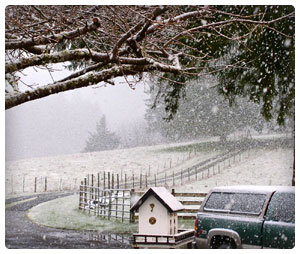Moving in the Snow
There’s a reason why most moves occur during the summer months. Along with temperatures being more favorable to work in, summer is a great time to move kids so that the school year isn’t disrupted. However, despite our best intentions, sometimes it becomes necessary to relocate during the winter months. There are tons of elements to worry about—rain, hail, and most importantly, snow.
- Prior to the move, remember to shovel as much snow out of your driveway as possible. You will have trouble loading and unloading your truck if there’s too much snow in the way. Try to stretch before you begin, as shoveling snow is demanding physical exercise.
- Salting the driveway is another imperative thing to try, as you can shovel snow away but you cannot shovel ice away. Rock salt is inexpensive and will melt ice away. Also consider magnesium chloride, which will melt ice at lower temperatures but produce less chloride byproduct. It is better for the environment because it is less harmful to plants than, say, calcium chloride or potassium chloride.
- Keep yourself hydrated. This may not come as naturally during the winter months as during the summer months, but it’s still very important. Likewise, try to protect yourself from harmful UVA and UVB rays with sunglasses and sunscreen—although it’s not as sunny in the winter, sunlight is still powerful and will bounce off the pavement and snow.
- Dress to stay warm but consider the fact that you will be engaging in a lot of physical exertion. It might be a good idea to pile on the layers so that as soon as you start sweating, you can take off a jacket or two.
- Keep your hands warm with gloves or mittens. They need to be in tip top shape if you’re going to be gripping and hauling heavy boxes around the driveway.
- Thermal socks are your friend! Wear them with heavy duty boots so that you don’t slip while bustling around.
- Certain things you may be moving, such as plants or electronics, are especially sensitive to the cold. Make sure to unpack them first and hustle them indoors to minimize contact with the harsh weather.
As soon as you start moving boxes indoors, lay out towels or rugs in the entryway so that if you have hardwood floors, there’s no chance of the snow melting and causing a slipping hazard. If you have a carpet, this might also be a good idea—you don’t want it to get wet because it will take upwards of a day to dry on its own.



